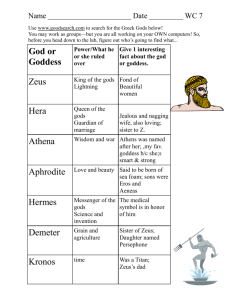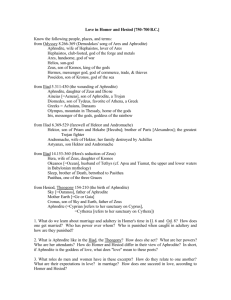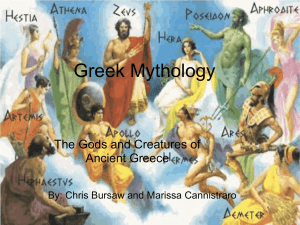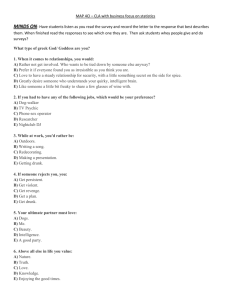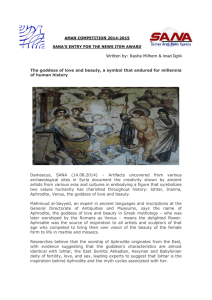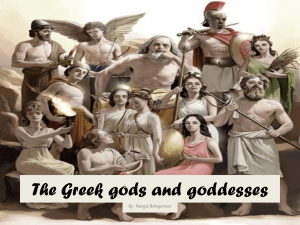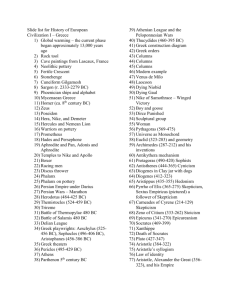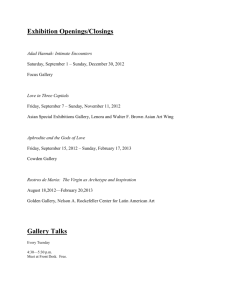the transformations of the armed aphrodite
advertisement
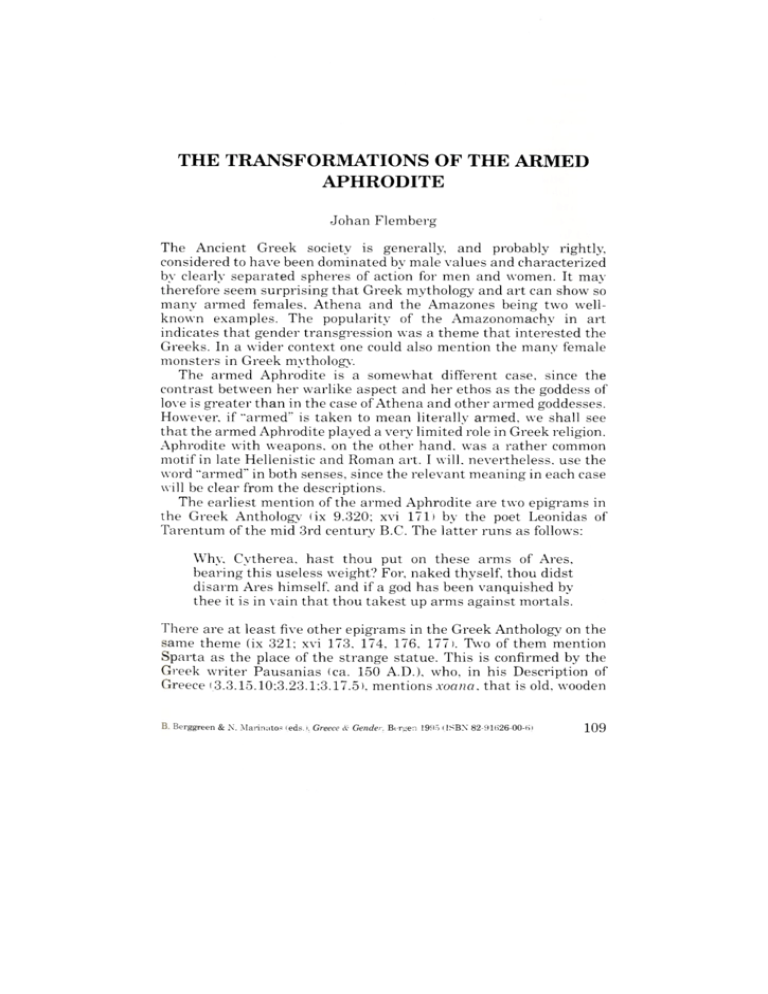
THE TRANSFORMATIONS OF THE ARMED APHRODITE Johan Flemberg The Ancient Greek society is generally, and probably rightly, considered to have been dominated by male values and characterized by clearly separated spheres of action for men and women. It may therefore seem surprising that Greek mythology and art can show so many armed females, Athena and the Amazones being two wellknown examples. The popularity of the Amazonomachy in art indicates that gender transgression was a theme that interested the Greeks. In a wider context one could also mention the many female monsters in Greek mythology. The armed Aphrodite is a somewhat different case, since the contrast between her warlike aspect and her ethos as the goddess of love is greater than in the case of Athena and other armed goddesses. However, if "armed" is taken to mean literally armed, we shall see that the armed Aphrodite played a very limited role in Greek religion. Aphrodite with weapons, on the other hand, was a rather common motif in late Hellenistic and Roman art. I will, nevertheless, use the word "armed" in both senses, since the relevant meaning in each case will be clear from the descriptions. The earliest mention of the armed Aphrodite are two epigrams in the Greek Anthology (ix 9.320; xvi 171) by the poet Leonidas of Tarentum of the mid 3rd century B.C. The latter runs as follows: Why, Cytherea, hast thou put on these arms of Ares, bearing this useless weight? For, naked thyself, thou didst disarm Ares himself, and if a god has been vanquished by thee it is in vain that thou takest up arms against mortals. There are at least five other epigrams in the Greek Anthology on the same theme (ix 321; xvi 173, 174, 176, 177 1. Two of them mention Sparta as the place of the strange statue. This is confirmed by the Greek writer Pausanias (ca. 150 A.D. ), who, in his Description of Greece (3.3.15.10;3.23.1;3.17.5), mentions xoana , that is old, wooden B Herggreen & N. Marinatos (eds. Greece & Gender. Bergen 1995 (ISBN 82-91626-00-6 109 JOHAN FLEMBERG ,f • \k . 4;;" J2.4 p ts? Fig. 1. Ishtar on an Assyrian cylinder seal. images, of the armed Aphrodite in temples in Sparta and at Kythera, further a temple of Aphrodite Areia (Warlike Aphrodite ) in Sparta, which contained xoana that were as old as anything in Greece". He also mentiones a statue (agalma) of the armed Aphrodite in a temple on the citadel of Corinth ( 2.5.1). We can therefore conclude that a cult of the armed Aphrodite existed in Laconia in early Archaic times, perhaps much earlier. We do not know exactly how the images looked, but most probably like palladict, i.e. standing female figures with helmet and shield and a spear in the raised right hand. The origin of this cult is not without importance for the present theme. In my opinion, the Oriental derivation ofAphrodite (which was the view of the ancients ) is basically correct, although an IndoEuropean component is undeniable. (This double origin is refiected in the stories of her birth: in Hesiod she is said to have arisen out of the sea-foam that gathered around the severed member of Ouranos. in Homer she is a daughter of Zeus and Dione. ) The warlike aspect is one of several traits that point to the Near East. The west-semitic goddess Astarte and her predecessors, the Babylonian Ishtar and the Sumerian Inanna, are well attested in texts and artistic represen- 110 THE TRANSFulnIXF1(iNS OF THE AI:MED APIIRuPITE tations as goddesses of love and war. To quote just a few examples from the first millenium, Ishtar is called "the lady of confusion, who makes battles terrible". and "the lady of battle, without whom hostility and peace exist not in the land and a weapon is not forged". In a prayer it is said: "It is within your power, Ishtar, to change men into women and women into men". A wall-painting frorn the palace at Mari. dated ca. 1800 B.C., shows Ishtar with maces on her back and a sword in her hand, standing on a lion in front of a king. Similar representations of Ishtar on seals (Fig. 1) and reliefs continue well into the first millenium. Anat, a West-Semitic descendant of Ishtar. is described in text from Ugarit as a fierce and blood-thirsty warrior. The combination of love and war is a striking feature and not easy to explain in an obvious way. But considering the importance of the Great Goddess, mistress of life and death, in the old civilizations of the Near East and Asia Minor, the all-embracing power of Innana, Ishtar, Anat and Astarte is not surprising. On the more basic level of human behaviour and psychology. the various connections between aggression and sexuality must of course also be taken into account. Further. a possible functionalistic explanation of the phenomenon is indicated by the connection of these goddesses with kingship, considering the role of the kings as leaders in war. Another problem is. ofcourse, whether one can speak ofgender roles when talking about deities. The divine world is not a copy of the human world. It is to be noted. for instance, that the bisexuality of Ishtar is hinted at in the sources. But granted that the world of the gods always to a significant degree reflects the society that shaped it. I think one can say that love and fertility on the one hand, and war on the other, represent female and male domains. respectively. The important thing is that these two functions were combined in the great goddesses of the East leven if there were war-gods, too. ) It is usually assumed that the worship of Aphrodite was introduced into Greece by the Phoenicians in the 9th or 8th century B.C.; Herodotus, in fact, says that the sanctuary at Kythera was founded by Phoenicians. I am more inclined to believe that the cult was introduced already in Late Mycenaean times, perhaps in the 12th century B.C. In either case Cyprus is a likely intermediate station. Be that as it may, the early Greek images of the armed Aphrodite in Kythera and Sparta, mentioned by Pausanias, make it likely that the first images of Aphrodite in Greece were armed. (The palladion type is probably derived frorn the 'smiting god type of representation, common in the Near East. ) The next important testimony, although a negative one. is a passage in the Iliacl. In the fifth book the gods interfere in the fighting 111 JOHAN FLEMBERG and Aphrodite, who is trying to rescue her son Aeneas, is wounded by Diomede. She is rescued by Iris and by her brother Ares and returns to the Olympus, where she is reproached by Zeus: "Not unto thee, my child, are given the works of war; nay, follow thou after the lovely works of marriage, and all these things shall be the business of swift Ares and Athene". For Homer, then, Aphrodite was clearly not a war goddess, unless, of course, this passage was aimed at a cult of a warlike Aphrodite that the poet for some reason disliked; as is well known, the Homeric songs ignore or barely mention some gods, for example Demeter, Dionysos and Adonis. However that may be, in the sources available to us Aphrodite is a love goddess, from Homer onwards. Indirectly, however, she was associated with war through Ares, her brother or husband. The significance of this connection is another difficult point; it may be due to the warlike aspect of the original Aphrodite, or, more likely in my view, it may be a function of Greek gender roles, matching strength and beauty The Greek tendency to antithetic thinking is another factor that is likely to have been at work here, as in the Theban myth of Harmonia, the daughter of Ares and Aphrodite. Now let us turn to the treatment of the armed Aphrodite in Greek literature and art. In Archaic and Classical times she only occurs in a few representations of the Gigantomachy, but since practically any god or goddess could take part in this fight, these instances cannot be regarded as evidence of a living notion of Aphrodite as a war goddess. Two Late Classical statues, the Aphrodite from Epidaurus and the Capua type, are more problematic and will be briefly dealt with later. The main version of the motif is the Hellenistic naked Aphrodite with a sword (Fig. 21. There are seventeen replicas known of this type, of various size. so the original was evidently a well-known work. It can be dated around 100 B.C. for stylistic reasons, but the sculptor is unknown and so is the place of origin. The original was probably an under life-size, bronze statue, set up as a votive in a sanctuary. The goddess is shown in the act of putting on a sword. The sword, in its sheath, is held by her left hand, while the right hand is putting the baldric on the shoulder. This is clearly not a war goddess, but the love goddess donning the sword of Ares. In some of the statuette versions and in the representations of the motif on Roman Imperial coins other martial paraphernalia are shown next to the goddess: shield, helmet and military cloak. It is hardly audacious to suggest that this statue is a parallel to the Hellenistic epigram quoted above. The goddess is seemingly acting as a man arming himself, but in reality she asserts herself as the mighty 112 THE TRANFORMATIONS OF THE ARMED APHRODITE Fig. 2. Aphrodite putting on a sword. Marble statue in Florence, Accademia di Belle Arti. Heigth 1.23 goddess of love and beauty, who conquers without weapons. If the sculptor got the idea of creating an 'armed Aphrodite' from the old xocina, he created exactly the same thing as the poets, changing a war goddess into the familiar love goddess and thereby reestablishing the normal gender roles of society. ( One copy of the naked Aphrodite with the sword, which was found in 1974 in Nea Paphos on Cyprus, has a drawn sword in her right hand; this is obviously due to a change, perhaps made when the statue was repaired after being damaged in an earthquakei 113 JnHAN FLEN1BERG Fig. 3. Omphale with club and lion's skin. Impression lst century B.C. Height 2.45 cm. of an amethyst seal. of the old It is, however, possible that the idea arose independently images. Aphrodite was firmly connected with Ares since Archaic times and already in the fourth century a similar motif, Erotes playing with known from in the lost painting, the weapons of Ares, is attested and Roxane by Aetion. of the wedding of Alexander literature, Further, in Hellenistic art the armed Eros is a not uncommon motif. A still closer parallel to the naked Aphrodite with the sword of Ares of Omphale with the is afforded by Late Hellenistic representations lion's skin and club of Herakles (Fig. 3 ). The play with contrasts is an art. In the case of the armed in Hellenistic element important the Aphrodite and Omphale, the contrast can be said to emphasize gender roles, but at the same time it makes the power of traditional 114 THE TRANSFORMATIONS Fig. 4. Aphrodite Pergamonmuseum. in the Pergamon OF THE ARMED APHRODITE frieze. Ca. 170 B.C. Height ca. 2 m. Berlin, the female apparent: both have triumphed over their lovers and taken their weapons, sword and club, as spoils. Thus a certain ambiguity is inherent in the motif. The German scholar Wiltrud Neumer-Pfau has recently stressed the importance of the negative view of women in ancient Greek society for the study of Greek art, especially Aphrodite statues. According to her view, women were generally considered to be cowardly and cunning by nature, and this influenced artists and public alike. Thus an ancient viewer of the statue of the naked Aphrodite with the sword would have been reminded of the inferiority and weakness of the female sex. Cunning certainly was considered characteristic of women in general and Aphrodite in particular, but in my opinion, the physical weakness of the female would have been counterbalanced in the mind of the beholder by the thought of the power the goddess. A better example of a cowardly Aphrodite is the armed Aphrodite of the Pergamon frieze (ca. 170 B.C.). Near the north-east corner of the altar the goddess is shown in front of two fallen Giants (Fig. 4). Eros 115 JOHAN FLEMBERG is flying ahead of her and Ares in his chariot is behind her, just around the corner, driving in the opposite direction. Aphrodite is dressed in a thin chiton and a mantel and is armed with sword and shield. With her right foot, clad in a nicely decorated shoe, she steps in the face of a dead, or dying, Giant, while she pulls a spear (thrown by Ares?) out the fact that of his body with her right hand. As already mentioned, as a fighting goddess here is not surprising. Aphrodite is represented and probably The way she fights, on the other hand, is unusual significant: attacking a dead or dying enemy is hardly brave but more suggestive of cowardice. Setting the foot in the face of the enemy is an action that often occurs in the Iliad and I doubt that it was regarded cruel, which has been the opinion of modern scholars as particularly as of the action, whether in this case. But on any interpretation cruelty or cowardice, I do not think that the artists of the Pergamon frieze were alluding to a warlike Aphrodite but rather making the most of the contrast given by the theme: the love goddess as a warrior. The naked Aphrodite with the sword is the best known version of the motif in sculpture. A probably earlier version was the original of Aphrodite using the the so-called Aphrodite of Capua, a half-naked shield of Ares as a mirror, usually dated in the end of the 4th century but "armed" may seem questionable, B.C. In this case the designation there is a possibility that the motif was intended as an allusion to the old, armed image of Aphrodite on the citadel of Corinth, since a statue of this type stood there, as shown by Roman coins (Fig. 5). The earliest rendering of Aphrodite in the act of arming herself is signed by Gelon, dated ca. 200 B.C. (Fig. 6). a beautiful ring-stone, holding the shield Fig. 5. Aphrodite Imperial coin from Corinth. 116 of Ares, with Eros at her side. Roman THE TRANSFORMATIONS OF THE ARMED APHRODITE The motif is well suited to the oval shape of the stone, in that the goddess stoops slightly in order to put the shield on her arm. A spear is leaning against her shoulder. Her light dress makes it clear that no depiction of a war goddess is intended and we can assume that the same general idea is at work here, viz. the disarming of Ares by Aphrodite. If an allusion to the old cult statues was intended in this case, is of course impossible to tell. The earliest representation of an armed Aphrodite to be considered here is the so-called Aphrodite from Epidaurus (Fig. 7). The original can be dated ca. 380 B.C. and is likely to have been a Peloponnesian work. Unlike the representations mentioned so far, this is a more passive figure, carrying a sword in the way it is normally carried, hung on the shoulder. Dressed in a thin chiton that has slipped from the right shoulder, revealing the breast, and a mantel, the goddess is clearly characterized as a love goddess. Since the hands are missing Aphrodite arming herself Impression of a garnet End of 3rd century B.C. Height 2.3 em ringstone from 117 JOHAN 118 FLEMBERG THE TRANSFORMATION OF THE ARMED APHRODITE we do not know what attributes she may have held, nor do the find circumstances of this statue give any certain clues to the function of the original. An old theory identifies it with the Amyclaian Aphrodite. made by Polykleitos, which was seen by Pausanias 3.18.1 ). That statue was part of a monument in the Apollo sanctuary at Amyklai south of Sparta. erected in memory of the Spartan victory over the Athenians at Aigospotamoi in 405 B.C. For various reasons I do not find this identification likely. There are. however. other possible locations. The statue could have belonged to one of the Peloponnesian sanctuaries of the armed Aphrodite or to one in which Ares and Aphrodite were worshiped together. In the first case the sword may have been a kind of allusion to the armament of the old image. in the latter case it would have been thought of as the sword of Ares. In any case. the fact that the goddess is armed can be explained without assuming that Aphrodite was still conceived of as a war goddess in Classical times. It is, however, far from certain that the Epidauros statue is a true replica of the original. There are five copies. only one of which has a sword; three of the others wear instead an animal skin. It is therefore possible that the original represented a Maenad and that the Epidauros copy is a later variant. With the Roman copies we have already come into Roman art. As is well known. the Rornans copied Greek masterpieces to a great extent and used Greek iconography for their gods. This is the case with Venus. too. in spite of the fact that this goddess. at least from late Republican times onward. played a greater role in the state religion than did Aphrodite among the Greeks. This was partly due to the importance of Mars. her consort. and to the fact that the Julian family regarded Venus as their ancestress. through Aeneas. the son of Aphrodite and Anchises. The martial aspect ofthis victorious Venus Venus Victrix J is. however. hardly more obvious in the iconography than that of the armed Aphrodite: she may hold a scepter or a spear )ut is not really armed and is often accompanied by a little Amor. The most common type. which occurs on Roman coins and seal stones. was argely taken over from late Hellenistic glyptic art cf. Fig. 6 a half- naked Venus leaning against a pillar and holding the arms of Mars. but also clear symbols usually a helmet. sometimes a sword 1Fig. )t.victory. such as an apple or a palm branch. occur. The type probably g. Aphrodite froin Epidaoros. ca. 380 B.C. Preserued heighl seo Roman marble 1.:50 iii. Athens. copy ot a Greek original National Archaeological 119 JOHAN FLEMBERG goes back to Caesar's signet ring, which is known to have had an image of the armed Aphrodite and which was taken over by Octavian. Iconographically, then, the motif is the same: the war god disarmed by the love goddess. But is the message conveyed the same? Is Venus victorious only in the sense that she conquers Mars? That this notion was familiar in Rome is shown by a passage in Lucretius' De rerum natura (1.29-43 ): For you alone can delight mortals with quiet peace, since Mars who often casts himself upon your lap wholly vanquished by the ever-living wound of love do you, bending around him from above, pour from your lips sweet coaxings, and for your Romans, illustrious one, crave quiet peace. But the political implications of the Roman Venus were more complex than that and the iconographical type under discussion is sometimes accompanied by the legend "Venus Genetrix". Venus, the goddess of love and grace (the original meaning of uenus, according to Schilling 1, also represented the Roman state and when she was depicted holding the arms of Mars the image was intended to evoke not only the power ofVenus, but at the same time that of Mars, the symbol of the military power of Rome. This, however, need not mean that the gender roles implied in this mythological, or allegorical, concept were much different from that of its Greek model. To sum up, the old Greek xoana of an armed Aphrodite, that we know existed in a few places, must originally have had a significance in accordance with their shape, i.e. the goddess must have had some quality that made the armed image appropriate. I do not think that her association with Ares is a likely reason, as the Hellenistic poets thought, or pretended to think. Nor is it likely that an Oriental goddess like Anat or Astarte was taken over unchanged by the Greeks. But if not a war goddess, the earliest Aphrodite may, in these places, have been a city goddess, as Athena was later to be in many cities, or the protrectress of a ruler, as Astarte and similar goddesses in the Near East seem often to have been. Later, when the Greek pantheon as we know it emerged, there was no place for a warlike or `political' love goddess. The protectress of cities was the virgin Athena. the mistriss of animals was Artemis, who also was thought of as a virgin. The love goddess was paired with Ares but otherwise thought of as the very opposite of war. The old images survived but were apparently not understood. Poets and 120 THE TRANSFORNIAT1ONS OF THE ARMED APHRODITE Fig. 8. Venus holding helmet and scepter. Roman coin of ca. 30 B.C. artists were attracted by the motif and transformed it in accordance with their notions of gender. The arms became ornaments or spoils, taken by the goddess from her consort, and the motif was turned into an allegory of the power of love. In terms of gender, this meant the superiority of the female, but in a very restricted sphere. It must, howver, be kept in mind that, although the interest in old and exotic cults was typical of the Hellenistic age, we cannot take it for granted that the artists were directly inspired by the old xoana and felt a need to re-interpret them. The starting point of the sculptor who created the naked Aphrodite with the sword, for instance, may well have been a desire to play with the normal gender roles and exploit the effects of contrast. The interest in Hermaphrodites in Hellenistic art is a parallel case. Concerning cults and rituals in connection with the armed Aphrodite, the sources tell us nothing and one can only speculate about the function of such cults in the Spartan state, where, as is well known, the training for war played a great role; and both Ares and Aphrodite were concerned with youth. It is also possible that the statues were associated with rites of "inverted normality", like the Hybristica at Argos, which celebrated an event (of doubtful historicity), at which the women took to arms and saved their city. In this and a few other instances the sources mention an Ares worshiped by women. The transformation of the armed Aphrodite can cat the risk of considerable simplification, it is true be seen as an instance of the process by which the Great goddess, who, as a goddess of love and fertility, Mistress of animals and protectress of kings, embraced a wide range of functions, was substituted by the Greek goddesses Aphrodite, Artemis and Athena. In terms of gender roles this would mean that the Greeks rejected a deity that involved an inversion of or mixing up of gender roles in favour of a `division of labour' among the gods. It is notable in this connection that Athena and Artemis were (or became ) virgin goddesses. In all this it is reasonable to see the effect of the more patriarchal, Indo-Europaean Greek society. The contrast between the world of the Great Goddess and that of Zeus, 121 JOHAN FLEMBERG father of men and gods, is succinctly expressed in the words of Zeus to Aphrodite in the Iliad. quoted above: "Not unto thee. my child, are given the works of Bibliography Flemberg, J.. Venus armata. Studien zur bewaffneten Aphrodite in der griechischrömischen Kunst. Stockholm 1991 (ActaAth-8 . 10 Graf. F.. 'Women. war. and warlike divinities. ZPE 55. 1984. 245-254 Neurner-Pfau, W.. Studien zur Ikonographie und gesellschaftlichen Funktion hellenistischer Aphrodite-Statuen. Bonn 1982 Diss. , Schilling. R., La religion romaine de Venus depuis les origines jusefau temps d'Auguste. Paris 1954 List of illustrations Fig. 1. Syria :32. 1955. fig. 23 Fig. 2. Photo by the author Fig. 3. From M.-L. Vollenweider. Die Steinschneidekunst und ihre Künstler in spatrepublikaMscher und augusteischer Zeit. Baden-Baden 1966. pl. 32:3 Fig. 4. E. Rohde. Pergamon Bingherg und Altar. Berlin 1969. fig.37 Fig. 5. 0. Broneer: "The 'armed Aphrodite. in Acrocorinth and the Aphrodite of Capua-. Berkeley 19:30 University of CalifMmia publ. in Class.Archaeology Fig. 6. From G.M.A. Richter. Engraved irems of the Greeks and the Etruseans. London 1968. ftg. 552 Fig. 7. Photo German Archaeological Institute. Athens Fig. 8 Photo Kungi. Myntkahinettet. Stockh .3m. Sweden 122
